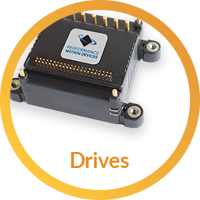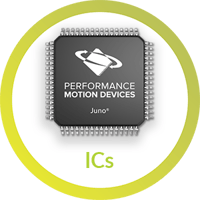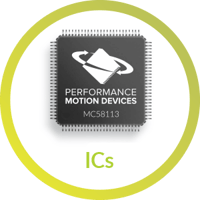Dusty Robotics provides an essential bridge between a building’s design and its construction. The ION/CME N-Series Motion Control Drive from Performance Motion Devices gives Dusty’s team the control needed for precision automated operation.
- Dusty Robotics’ FieldPrinter autonomous mobile robot requires precise control to enable layout accuracy for construction customers. PMD’s ION/CME N-Series Motion Control Drive is instrumental to the robot’s position accuracy of 1/16 of an inch.
- PMD’s N-Series drives give robotics engineers essential insight and access to internal control parameters needed to customize and troubleshoot.
- The N-Series is a compact, PCB-mountable single-axis controller that provides high-performance motion control, network connectivity, and amplification in a tiny footprint.
As urbanization accelerates and infrastructure demands grow, the construction industry is under extreme pressure to keep pace. Labor shortages, rising material costs, and increasing demands for speed and precision are pushing builders to seek automated solutions that improve not only efficiency but safety and sustainability as well.
It’s within this space that Dusty Robotics saw a particular need for a system that could automate the translation of building designs to the floor of a construction site. Too often, there is a considerable gap between a building’s design and 3D model and what actually gets built. As various trades lay out their plans, mistakes and outdated information often lead to incorrect layouts, rework, and delays in production.

The FieldPrinter autonomous mobile robot translates a building’s 3D model into 2D drawings on the floor, overcoming incorrect layouts,
rework, and delays in production. Source: Dusty Robotics
As the industry moves to tablets or laptops for plan information, the days of a 4-inch-thick set of blueprints covering each floor and each trade are mostly gone. But the typical process still requires that an individual manually transfer that information onto the ground, explains Mike Thompson, principal engineer for Dusty Robotics.
“The consequences of that person getting that information wrong could be a wall being built 1 inch out of place or it could be 12 inches out of place, in which case the builder would probably have major problems,” he says.
It’s also a very manual process. Depending on the site, the team might have a total station (a surveying instrument integrating several measurement tools) and chalk lines or perhaps just people with tape measures and chalk lines — a technique that hasn’t changed in centuries, Thompson notes. “It’s a person on their knees laying down the information, writing with a grease pen,” he says. “In a lot of cases, there isn’t any information. They don’t have the time, and it’s just very labor-intensive.”
Dusty Robotics AMR: The FieldPrinter
Dusty Robotics has pioneered a mobile robotic system that alleviates all those pain points. The company’s FieldPrint Platform translates a building’s 3D model into 2D drawings on the floor of the facility, preventing the miscommunications and mistakes common in the field.
“We’re bridging that gap with a design field communication platform that takes all of the things you’ve modeled and all the things you’ve designed for a building and makes it physically there on a job site floor with 1/16 of an inch accuracy,” says Zachary Reiss-Davis, senior director of marketing for Dusty Robotics. “The construction team no longer has to be referring back to their laptops, to their iPads, to their paper plans to know what needs to be built, where it needs to be built, and how it needs to be built. Instead, all of that information — across all of the trades, across all the stakeholders involved in a construction project — is right there under their boots and available a lot faster, a lot more accurately, and with a lot better collaboration.”
Key to the robot’s precise performance are two off-the-shelf compact motion controllers from Performance Motion Devices (PMD). Each ION/CME N-Series Drive provides control and power for each of the two front wheels. (The rear wheel has no active drive.) Together with a suite of onboard sensors that provide precise location information — including trackers, encoders, and IMU (inertial measurement unit) gyroscopes — the PMD drives are vital to achieving the robot’s position accuracy of 1/16 of an inch.
![]()
PMD’s ION/CME N-Series Drives are compact, PCB-mountable modules that provide high-performance motion control, network connectivity, and power amplification. They measure 37.6 x 37.6 x 16.8 mm and deliver up to 1 kW of power.
“We want the robot to move very smoothly, and as someone would expect, so we don’t want to be accelerating and decelerating a ton. We want it to be a continuous motion between all the different objects that we print,” says Ryan Dimick, controls engineer for Dusty Robotics. The control system has to allow for constant profile changes as the robot switches between navigating and printing.
“That is where the PMD drives come in, allowing us to transition smoothly from the different operations.”
Dusty Robotics recently launched its FieldPrinter 2, improving on its previous robot with the help of the PMD controllers. The motion controllers from another vendor used in the first version of the robot created some challenges for Dusty’s developers, including an inability to understand and rectify errors without coming up with workarounds.
Dusty Robotics needed to find an alternative that would provide the performance it was looking for and would also fit into its existing platform. The team found that not only was the PMD N-Series drive a good fit for Dusty’s existing platform, but it also helped overcome significant challenges that the Dusty development team had been facing with its previous motion controllers.
N-Series Provide the Control
The N-Series is a compact, PCB-mountable single-axis controller in PMD’s ION Drive family, providing high-performance motion control, network connectivity, and amplification in a tiny footprint measuring only 1.48 x 1.48 x 0.66 in. (37.6 x 37.6 x 16.8 mm). It is an all-in-one drive with a built-in processor, giving Dusty the ability to download and run code. The N-Series helped overcome challenges the Dusty development team had faced with its previous motion controllers.
“One of the main reasons we liked the PMD drive was that we had control over everything.”
Dimick points out. “We could provide it with the parameters we wanted, and we had visibility into what was happening inside the controllers themselves.”
The PMD drives gave Dusty Robotics the visibility and customizability it wanted. “And when we would run into an issue, it was always something we could fix,” Dimick says. “We were able to overcome any of the latencies that we had in the past and really set our own timing characteristics for the motors and the motor control.”
One of the features Dusty wanted access to was the ability to modify the control loop and the field-oriented control loop parameters, Dimick adds.
“In our previous units, these were fixed parameters that we had to work with. Being able to adjust those using PMD’s Pro-Motion software gave us more options to determine the optimal tuning for the robot.”
As Dimick worked to perfect the electronics within the latest-generation robot, that added insight from the PMD motion controllers was invaluable. “[Dimick] is constantly pulling data into spreadsheets, graphing it, and really looking at all the inputs to the motor controller, and the outputs, and really understanding what small tweaks we need to actually achieve the goals that we want to achieve,” Thompson explains. “That ability to bring those graphs into alignment with what his expectations are — that was a very big challenge before.”
Dimick adds, “We’re working on a millisecond-level time scale. Getting a lot of information very quickly is very important for all the tuning and the high-level controls, and we were not able to achieve that prior to PMD.”
Flexibility in Controller Communication
Throughout the development journey, Dusty Robotics has been able to collaborate closely with the PMD team to help resolve challenges.
“Any time I was integrating the controller into our product and had any questions, they were always very quick to jump on a call and point me in the right direction in terms of what features of the robot or the drive I should be looking at,” Dimick says.
“They even released a custom debug version for me to use temporarily to help me diagnose an issue I was having. In terms of getting them fully integrated into our process, they were really helpful along the way.”
This collaboration served Dusty well as it sorted out the ideal communication interface for its purposes. PMD’s N-Series drives come with a range of communication options, including Ethernet, CAN, RS-232, RS-485, and SPI (Serial Peripheral Interface).
Dusty had a good idea of what communication it wanted, which was coming in a slightly later version of the controller. “So we waited on it,” Dimick says. “And then I think we were one of the first people to really use it. We helped them debug some of the firmware, and they quickly turned around versions for us to be able to use it.”
FieldPrint Platform Overview Video
Source: Dusty Robotics
Overcoming Blind Spots in the Field
That communication is important for overcoming difficulties with inevitable obstacles throughout a construction project.
A key technology for Dusty’s FieldPrinter is a very precise laser tracker that continuously reports to the robot about its position within its environment. But many times throughout a workday, the tracker does not have a view of the robot — operating within a blind spot. The controller, and its operation with the robot’s other sensors, is vital to keeping the robot on track.
“When the robot is printing within a blind spot, not visible to the tracker, it is literally relying on the inertial measurement unit; it’s relying on the encoders that are coming through the PMD controller. It’s relying on all the other sensors that we put into the robot so it can go five, 10, 15 seconds of continuous printing,” Thompson explains. “Then, when it comes out of the blind spot, it tells the tracker exactly where it is. We need to give that tracker the accuracy so it can acquire the signal very quickly, very precisely. The precision that we can operate the robot with while it’s out of view is very critical.”
That’s where a lot of the sub-millisecond timing precision comes in, to overcome the blind spots that are not uncommon at cluttered job sites, Dimick adds. “The ability to maintain accuracy in blind spots is a tough problem, and that’s where the sub-millisecond timing is critical,” he says. “That information, combined with the smooth, predictable motion, enables the robot to accurately estimate its location and continue printing without line-of-sight to the laser tracker.”
This blind spot printing is one of Dusty’s biggest improvements in its latest robot version, according to Dimick.
“The PMD drives and the information we can get out of them, and the quality of it, has really helped us achieve that performance,” he says. “It’s a vast improvement from the previous product to this.”
Navigating Other Dangers
Construction job sites are often cluttered with obstacles, floor penetrations, and unprotected edges of the building, Dimick notes, and Dusty uses PMD’s internal braking scheme to help navigate those dangers.
“We have cliff sensors mounted on all four corners of the robot looking for these ledges that could pose a threat to the robot. When we detect a ledge, the robot automatically applies the brakes and navigates away from the ledge,” he explains.

PMD’s N-Series motion controller provides added safety as Dusty’s robot obstacles, ledges, and other dangers.
Source: Dusty Robotics
Dusty is able to use the PMD drive to apply an electronic brake to the motors. “There’s a pretty complicated set of actions that the robot has to do when it detects this, and a lot of it goes through the PMD interfaces,” Dimick says.
A bit of Dusty’s own software, running on one of the chips in the PMD controller, serves as a watchdog, Dimick adds. “If it loses communication to the robot, it powers down the motors.”
As the company name implies, Dusty’s robots must operate in very dusty, dirty environments, and they must be able to withstand all kinds of weather. “We have to work in the Arizona sun when it’s 110 degrees out, and we also have to work on the 14th floor of a Chicago building in February, when it’s minus 20,” Thompson says.
Far from a controlled, sterile factory, the FieldPrinter must be more durable, more reliable, and capable of operation in those harsh environments — with unknown obstacles and unknown internet connectivity, Reiss-Davis says. Being able to deal with “those complex, dirty, dusty environments is something we know our clients expect from us, and that’s something we look for in technology partners as well.”
Unlike competing solutions, which leave sensitive electronics exposed to environmental hazards, the N-Series drive comes standard with an enclosed package to protect internal components.
Moving Forward
Dusty Robotics continues to look at ways to improve its platform further. Like any technology company, Thompson says, it’s always interested in higher levels of integration. Developers will continue to look to PMD to help achieve their goals.
“PMD provides a pathway for us. Not only do they provide the controllers themselves, but they can open up their controllers and give us access to the independent parts that allow us to create a highly integrated solution,” Thompson says.
“It’s something that we haven’t really pursued in any detail, but it is a pathway that allows us to preserve our investment that our engineers have made in what we have today. We can preserve that and still achieve some other engineering goals around integration to make the system faster, lighter, and even better than it is today.”
Motion Control Products for AMRs
Performance Motion Devices has been producing motion control ICs that provide advanced velocity, position, and torque control of DC Brush, and Brushless DC motors for more than thirty years. Since that time, we have also embedded these ICs into plug and play modules and boards. While different in packaging, all PMD products are controlled by C-Motion, our easy-to-use motion control language, and are ideal for use in medical, laboratory, semiconductor, robotic, and industrial motion control applications. Notably, our solutions are also increasingly integrated into Autonomous Mobile Robots (AMRs), where precise, reliable motion control is critical to performance and efficiency.
ION/CME N-Series Digital Drives
N-Series ION Digital Drives combine a single axis Magellan IC and a high performance digital amplifier into an ultra-compact PCB-mountable package. In addition to advanced servo and stepper motor control, N-Series IONs provide S-curve point to point profiling, field oriented control, downloadable user code, general purpose digital and analog I/O, and much more. With these all-in-one devices building a custom controller board is a snap, requiring you to create just a simple 2 or 4-layer interconnect board.
Learn more >>
Juno Family of ICs
The Juno family of ICs excel at velocity and torque control, with features such as FOC (Field Oriented Control), profile generation, high/low switching amplifier control signal generation, leg current sensing, and more. Available in packages as small as 7mm x 7mm and costing $12 in quantity, these ICs are an ideal solution for your next design.
Learn more >>
Magellan MC58113
The MC58113 series of ICs are part of PMD’s popular Magellan Motion Control IC Family and provide advanced position control for step, BLDC, and DC Brush motors alike. Standard features include support for CAM profiles, trapezoidal & s-curve profiling, direct encoder and pulse & direction input, and much more. MC58113 ICs have an advanced trace capability that lets you collect critical performance data as fast as twenty times per mSec, or as slow once a day.
Learn more >>
You may also be interested in:
- Robotic Wheel Drive (Motion Application)
- Mathematics of Motion Control Profiles (Article)
- Build vs Buy of a Three Axis Motion Controller (Article)
- Precision Torque Control (Motion Application)
- Introducing ION/CME N-Series Digital Drives (Webinar)
- Field Oriented Control (FOC) - A Deep Dive (Article)





